Category: News
Robbins Crossover XRE is World’s Fastest TBM over 13 Meters in Diameter

Personnel from contractor Kolin Construction and Robbins celebrate the breakthrough of a Crossover (XRE) TBM after it completed Turkey’s Esme Salihli Railway Tunnel.
In October 2021, the breakthrough of a Robbins Crossover XRE TBM was the cause of much celebration. A team of personnel from Kolin Construction, Turkish State Railways (TCDD), and Robbins field service gathered to watch the breakthrough of the world’s fastest TBM over 13 m (43 ft) in diameter.
The 13.77 m (45.18 ft) XRE TBM set world records three times over, beating its own records in May and June with a set of records over the summer, including a best day of 32.4 m (106 ft), a best week of 178.2 m (584.6 ft), and a best month of 721.8 m (2,368 ft). Launched in March 2021, the machine bored 3.05 km (1.90 mi) on the Esme-Salihli Railway Tunnel as part of the Ankara-İzmir High Speed Railway Project for the TCDD.
“When the strength, force and torque generated by our Crossover TBM are taken into account, we consider it to be a beast. It has performed extremely well in this tunnel,” said Onur Kansu, TBM Manager for project contractor Kolin Construction. He added “We are proud we have accomplished such high performance.”

The Robbins Crossover XRE TBM broke through in October 2021 to much fanfare.
The machine began its bore in altered gneiss, then passed through mélange consisting of gneiss, sandstone, claystone, mudstone, quartz, and silt. By the end of the bore the machine was excavating in mainly mudstone. Core drillings were taken every 200 m prior to boring so the crew felt confident with the geology—just one of several factors that contributed to the record rates. “A proper geological analysis, choosing the right TBM, a professional crew and a contractor who believes that they can break records are all key,” said Kansu. “Scheduled maintenance periods, an expert team, availability of sufficient spare parts, and good logistics also made it possible for us to reach our targeted advance rates.”
The project is particularly important for the Turkish tunneling industry, showing what is possible at larger TBM diameters. “We have disproved the idea that it is difficult to reach high advance rates while boring in EPB mode with large diameter TBMs. Crossover TBMs enable us to find quick solutions in changing ground, so we believe they will be the preference for future projects,” said Kansu.
With tunnel excavation finished, work will continue on the 508 km (316 mi) line that will connect Polatlı in Ankara Province to Izmir, the third most populous city in Turkey. Once complete, the Ankara-İzmir High Speed Railway will be the longest rail line in the country, conveying passengers at top speeds of 250 km/h (160 mph) in a railway journey of about 3.5 hours.
Robbins develops Rectangular Rock Mining Machine for Flat Invert
Robbins’ latest innovation is making good headway on a non-circular tunnel excavation in hard rock. The rectangular TBM, known as the MDM5000 (standing for Mine Development Machine with dimensions of 5.0 m x 4.5 m) is capable of excavating a flat tunnel invert for immediate use by rubber-tired vehicles. Employed by Mexico’s oldest silver mine, Fresnillo Plc, the MDM5000 is boring a mine access tunnel in andesite and shale with quartz intrusions that has defied earlier attempts using roadheaders. The successful operation is the result of extensive discussions between Robbins, who designed and supplied the machine, with TOPO machinery and Fresnillo Plc. View the video of the machine in action here.

Developed by Robbins for use in rock up to 200 MPa UCS, the MDM5000 excavates with a reciprocating cutterhead and swinging cutterhead motion to create a rectangular cross section tunnel.
“We decided to work with Robbins for their experience. A lot of people have tried to provide these kinds of machines but nobody has done it. Robbins used their experience and their skills to provide us with a rectangular profile machine,” said Fidel Morin, Projects Superintendent for Fresnillo Mine.
The technology is not only useful for the mining industry, but also for many applications in civil tunneling. While other machines have been developed for soft ground, the MDM5000 represents the first successful foray into rectangular hard rock tunneling. “We’re very pleased to add non-circular tunneling to our wheelhouse of solutions that continues to include TBMs, conveyors, cutters, and more. We see applications for the MDM wherever a rectangular profile is needed, such as train tunnels requiring a flat invert. In a traditional circular tunnel, the invert is filled or an invert segment is needed, but with the MDM 30% less rock is required to be removed from the profile,” said Robbins President Lok Home.
With more than 1,700 m of advance thus far at rates up to 52 m in one week and 191 m in one month, the MDM is significantly faster than drill & blast excavation. “We’re making history. Fresnillo is always looking for new technology, and we believe that the usage of the MDM5000 is going to be something extremely successful, not only for our company but also for the industry,” said Morin.
The MDM5000 has undergone major component enhancements during the course of its successful bore at Fresnillo mine. It was first transported to the -695 m level of the mine and underwent final assembly and launch in a cavern, where sections of the MDM were moved by crawlers and pieces were lifted by hoist. The machine is now boring a 270-degree spiral to end above the original tunnel. It will then be backed up to the original tunnel and continue driving straight ahead.
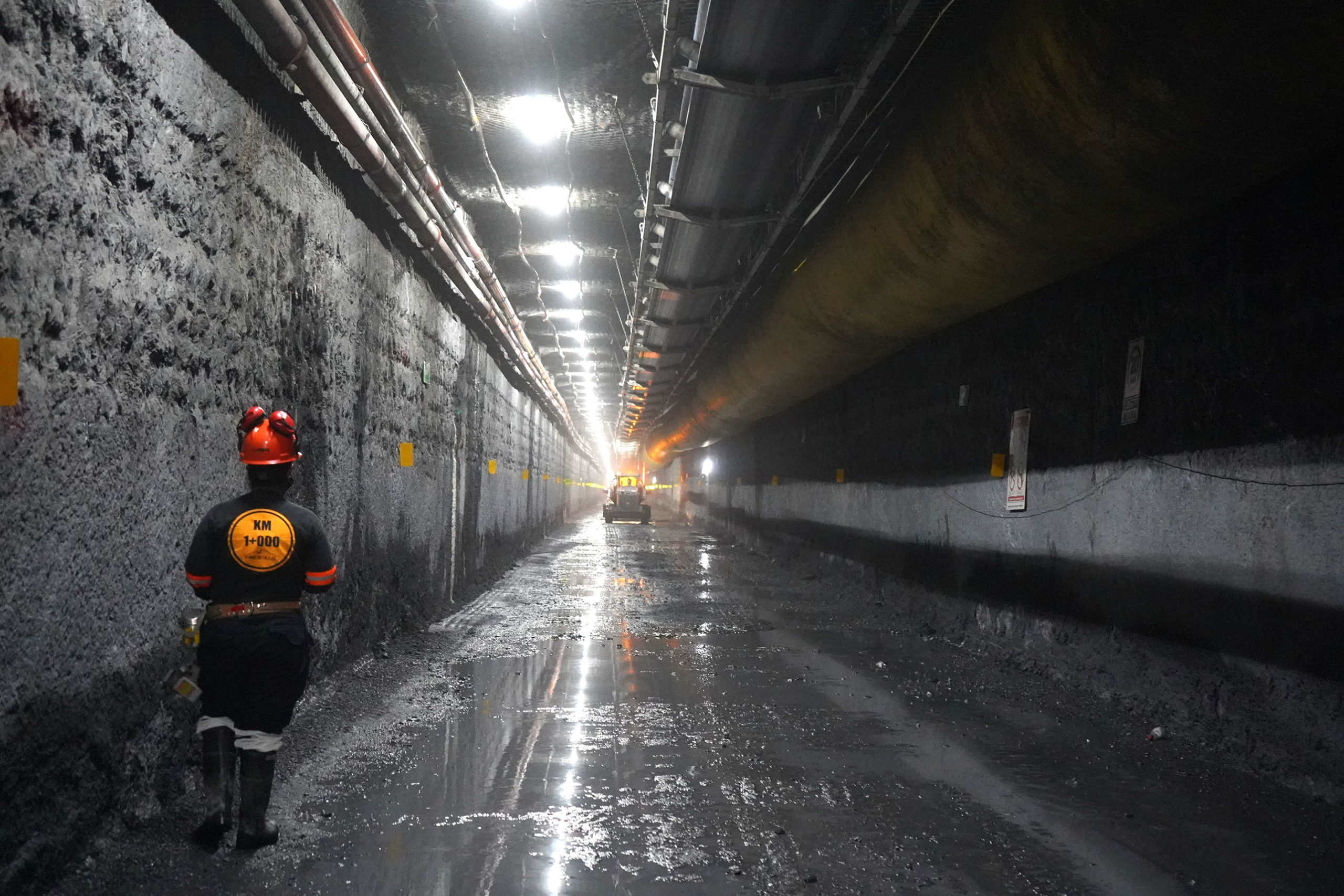
The MDM5000 is particularly useful wherever a rectangular profile is needed, such as train tunnels requiring a flat invert. The rectangular profile requires 30% less rock to be removed as compared with a circular cross section. Photo credit: Fresnillo Plc
Developed for use in rock up to 200 MPa UCS, the MDM5000 utilizes disc cutter technology proven on traditional, circular TBMs. During excavation a reciprocating cutterhead and swinging cutterhead motion create a rectangular cross section tunnel.
The MDM offers a number of advantages over drill and blast. MDM tunneling has advance rates roughly twice those of a drill and blast heading, and results in smooth tunnel walls, less overbreak, and minimized ground support. The increased advance rates are partly due to the machine’s continuous progress, unlike drill and blast operations where crews must exit the tunnel during blasting for safety. In addition, simultaneous ground support installation further increases overall advance rates compared with drill and blast operations that must install ground support sequentially.
View the machine boring at Fresnillo mine: https://youtu.be/mgFopWaf220
Turkish TBM Records, Twice Over
History has been made twice over at Turkey’s Eşme-Salihli Railway Tunnel where a 13.77 m (45.18 ft) diameter Robbins Crossover XRE TBM has set new world records for best day, week, and month in the 13 to 14 m (42.6 to 46 ft) diameter range. The machine broke all three records first in May with 25.3 m (83 ft) in one day, 117 m (383.8 ft) in one week, and 345.6 m (1,134 ft) in one month, then again in June with 28.5 m (93.5 ft), 133.2 m (437 ft), and 455.4 m (1,494 ft) respectively. The TBM, which sat in storage for seven years before being newly upgraded for this project, proves the robust durability of Robbins machines.
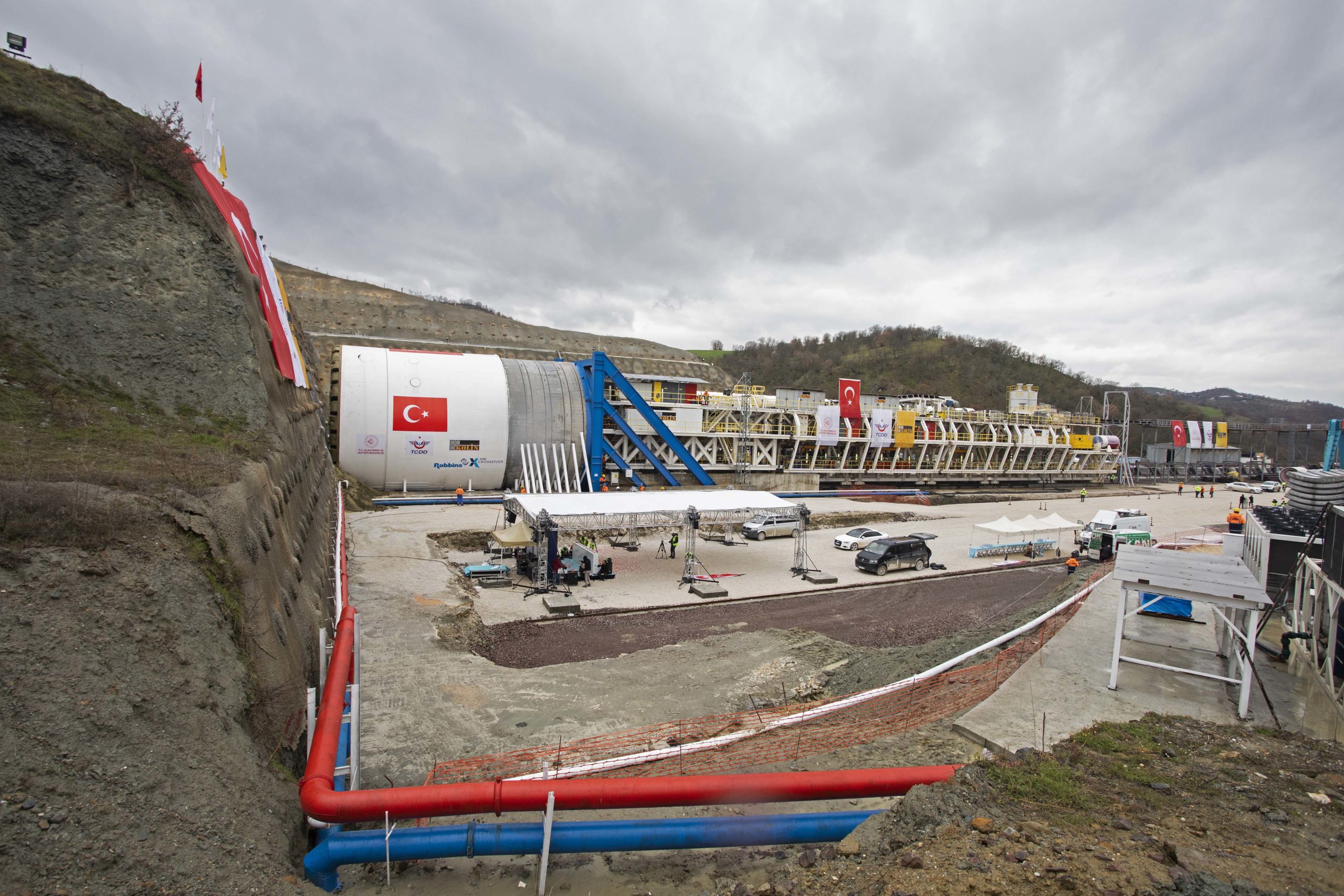
Thus far the Robbins machine has encountered a mix of mudstone and gneiss.
The Crossover TBM surpassed all previous performance rates by a machine in its size range. The closest another 13 to 14 m (42.6 to 46 ft) machine has come to these numbers was a 13.7 m (45 ft) diameter mixed ground TBM that achieved a 7 m (23 ft) average per day and a best day of 12 m (39 ft) at the Eurasia Tunnel project.
Onur Kansu, TBM Manager for project contractor Kolin Construction, attributes the machine’s success to the team operating it: “The most important reason for achieving fast advance rates is that we have an experienced and qualified team. If we open it up even further, such a team allows us to anticipate the malfunctions and to go to the solution in a very short time. In addition, all necessary maintenance is carried out on time, and the appropriate consumables are selected to increase the performance.”
The machine launched on its 3.05 km (1.90 mi) bore at the end of March 2021 as part of the Ankara-İzmir High Speed Railway Project for the Turkish State Railways (TCDD). Thus far the machine has encountered a mix of mainly mudstone with gneiss. “When we look at the overall tunnel geology,’ said Kansu, “we are excavating in complex and weak ground. In this geology, the advantages of the Robbins XRE TBM are highly favorable. The Robbins XRE TBM shows high performance in both complex and weak ground. It should also be noted that the TBM is very strong when looking at parameters such as torque and thrust.” To get through the challenging conditions, the large diameter XRE has a number of unique features. The large diameter design enables both a screw conveyor and belt conveyor to remain in place, enabling swift conversion between modes, and operation in full EPB and hard rock modes.
Regarding the future of the Turkish tunneling industry, Kansu is optimistic about the effects these new records will have: “It has been seen how well the engineers and application teams in Turkey have excelled in complex geologies and the large-scale tunneling industry. At the same time, it has shown to the whole world, especially Turkey, that with the right choices, it is possible to carry out excavations of this scale and complex geology without any problems and quickly. This project will be a pioneer in the Turkish tunneling industry, showing that faster and more economical tunnels can be built.”
Robbins XRE TBMs Cross the Finish Line in Massive Metro Project
In Spring 2021, the second of two 6.65 m (21.8 ft) diameter Robbins Crossover XRE TBMs made its third and final breakthrough for India’s Mumbai Metro Line 3. The first machine made its final breakthrough for the project in late April. The tunnel drives were a triumph for joint venture contractor Larsen & Toubro and the Shanghai Tunnel Engineering Company (L&T – STEC), as the crew and equipment overcame unpredictable terrain, high-pressure water ingress, and government-imposed lockdown orders during the Covid-19 pandemic.
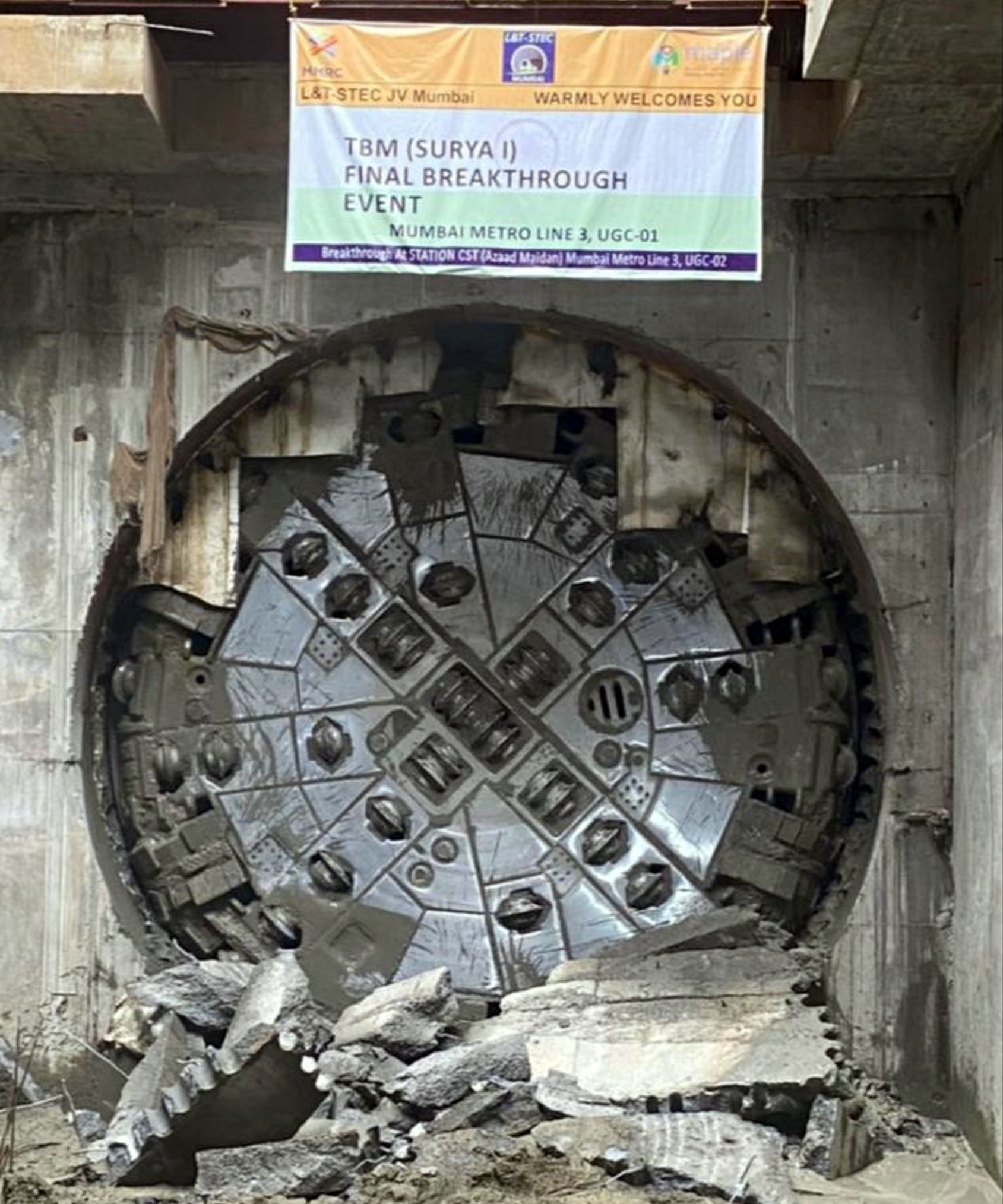
The first of the Robbins Crossover machines broke through in April 2021.
The two custom-built machines were selected to bore parallel 2.9 km (1.8 mi) tunnels between the Cuffe Parade station and CST stations, breaking through into several station sites along the way. “It is the first time in India that Dual Mode, Crossover type TBMs equipped with a horizontal screw conveyor and high torque / high speed (two-speed) cutterhead drives were used. Overall, the performance of the Crossover TBMs was found satisfactory and we are in the process of shifting these TBMs for the L&T Chennai Metro project,” said Mr. Palwinder Singh, Head – Tunnel Construction for the L&T – STEC JV.
In another first for India, the Crossover TBMs employed a unique technique in a 554 m (1,820 ft) long section from Hutatma Chowk to CST stations. They were used in the benching of the NATM Platform tunnel through basalt rock (removal of the bottom section of rock remaining in the station after conventionally removing the top section). “This requires fine control on the operational parameters of the TBM because only 25% of the cutterhead is excavating the rock mass, while the remaining 75% of the cutterhead has no contact with rock or soil. In addition, the TBM was relaunched without using a reaction frame, instead taking reaction from half segments erected during the benching of the NATM Platform Tunnel. These innovative concepts were accomplished for the first time in India at Mumbai Metro Line-3, Package 1, and I therefore have many reasons to feel proud on the completion of tunneling,” said Singh.
L&T – STEC made impressive progress throughout tunneling despite the many exacting circumstances surrounding the scope of work. Above ground, the joint venture not only had to navigate the restrictions of working within an urban environment, such as limited work hours and the slow removal of muck due to minimal space and traffic, but also faced concern for major structures such as the Mittal Towers and the historic Bhikha Behram Well located along the tunneling route. The Crossover TBMs excavated with only 15 to 20 m (49 to 65 ft) of cover separating them from these important structures, which had to be instrumented to monitor vibrations, movements, and potential settlement.
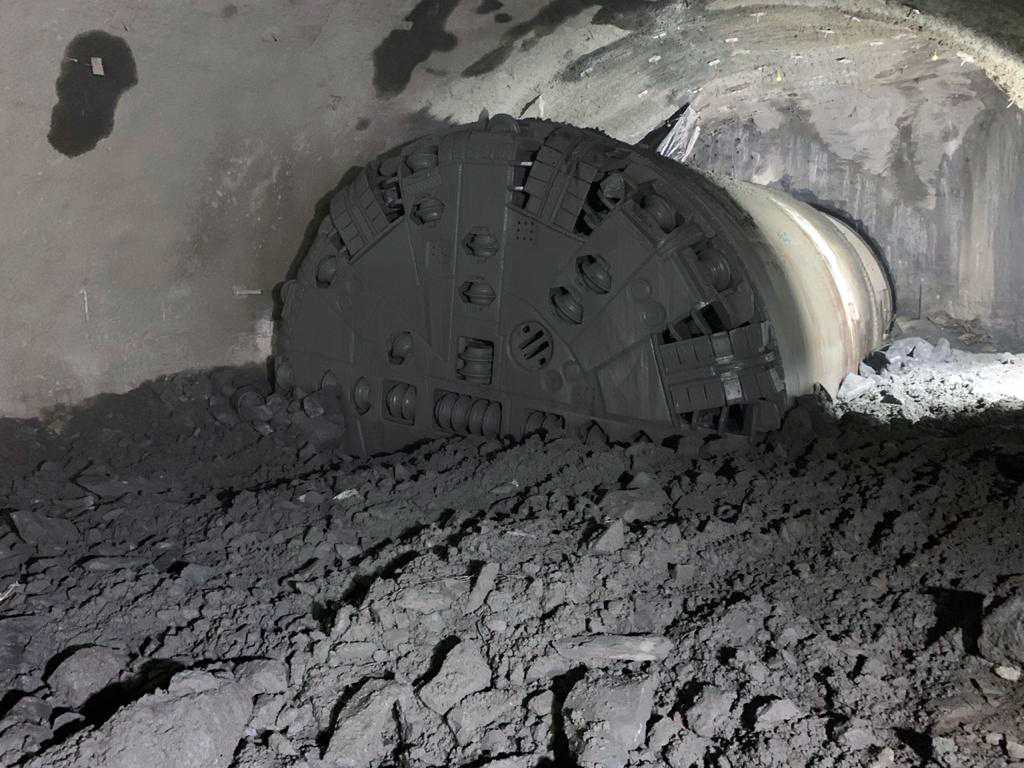
In a first for India, the Robbins Crossover TBMs were used in the benching of the NATM Platform tunnel through basalt rock in a 554 m (1,820 ft) long section from Hutatma Chowk to CST stations.
Underground, L&T – STEC faced a complex geological mix of fresh greyish basalt, soft volcanic tuffs, shale, and breccias—consolidated rocks of angular fragments of disintegrated volcanic rock. One of the biggest concerns, however, came from the tunnels’ proximity to the coastline of the Arabian Sea. During one point, TBM 1 was only 25 m (82 ft) from the coastline, with the invert level of the tunnel running approximately 22 m (72 ft) below mean sea level. As anticipated with circumstances such as these, the Crossovers faced a significant amount of groundwater with up to 300 liters/min during their excavation.
Despite these obstacles, the TBMs were still able to maintain impressive rates. TBM 2 even completed one push in a swift 14 minutes. “In fact, the boring rate of the Crossover TBMs was never an issue for us. It was only limited by the rate of muck removal and we could have finished the tunnels much faster,” said Singh.
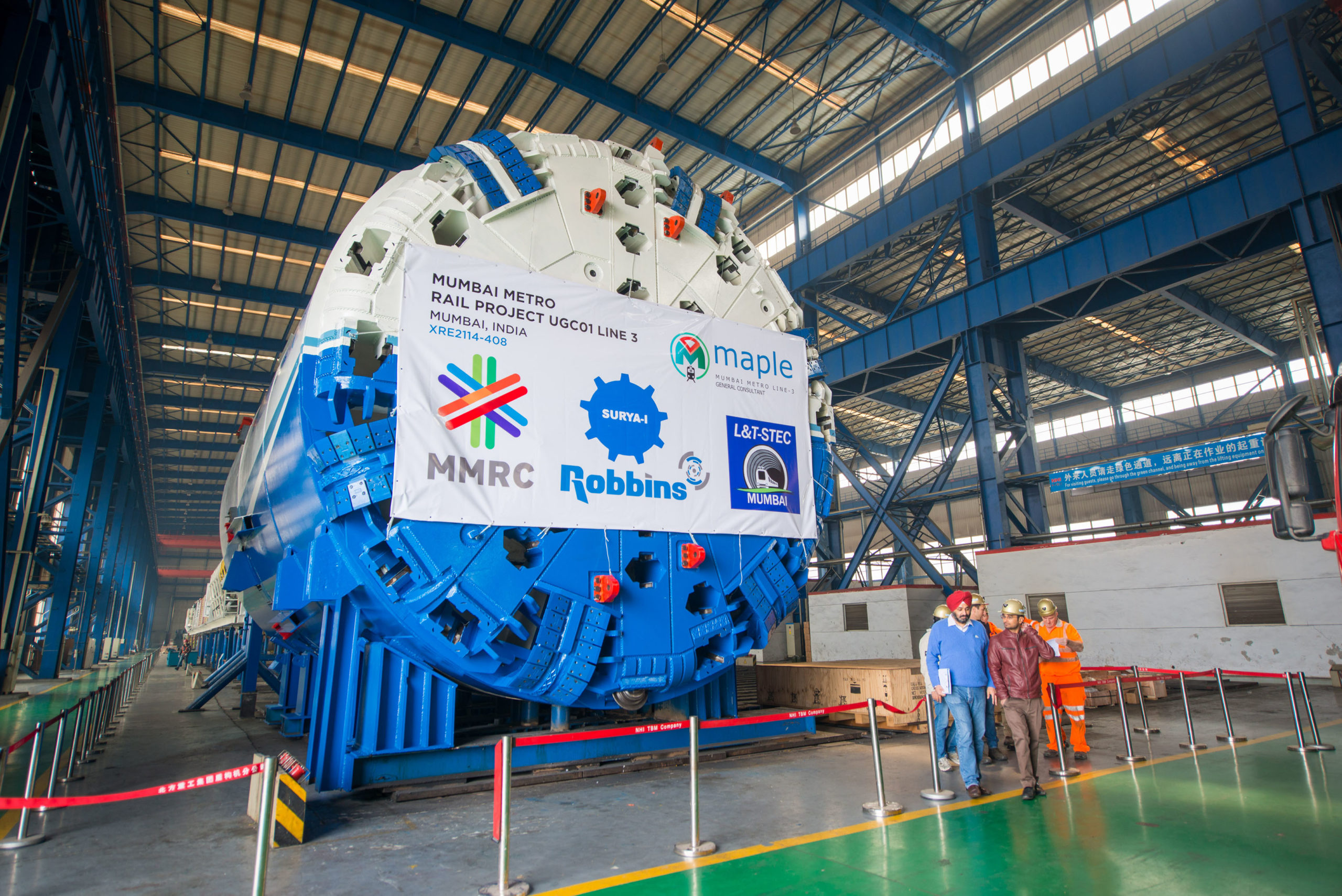
The Robbins Crossover TBMs were the first machines of their kind employed in India, using both a horizontal screw conveyor and high torque / high speed (two-speed) cutterhead drives.
L&T engineers were highly involved in the specifications and designs of the machines and worked closely with Robbins to prepare for the challenges the project presented. While L&T had extensive tunneling experience, tunneling with a Crossover machine was entirely new to them. To remedy this, Robbins provided a team of key personnel to train L&T in all aspects of the machines’ design and operation. “Working with Robbins field service was more than satisfactory. Even during the Covid-19 pandemic times, Robbins field service was available 24 hours a day, 7 days a week. What else can one expect?” said Singh.
Each milestone reached on this project is another step closer toward significantly improving the lives of Mumbai residents. As the financial capital of India and one of the most populated cities in the world, Mumbai is faced with an excessive amount of road traffic. It currently takes up to two hours to drive the 25 km (15 mi) distance from Cuffe Parade to the airport—the same trip on the finished metro will take a mere 50 minutes. The completion of Mumbai Metro Line 3, which is expected in 2025, will not only save residents transit time, but is expected to initially decrease road traffic in the area by 35%, reducing daily fuel consumption by 460,000 liters.
Robbins XRE TBM bores Eşme-Salihli Railway Tunnel
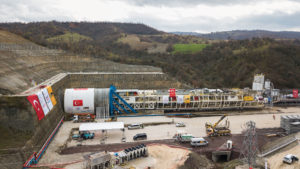
A Robbins Crossover machine is boring Turkey’s 3.05 km (1.90 mi) Eşme-Salihli Railway Tunnel through mixed conditions including sandstone, gravelstone, claystone, and siltstone for contractor Kolin Construction.
A Robbins 13.77 m (45.18 ft) diameter Crossover XRE TBM launched recently in spring 2021 in Eşme, Turkey. The large machine is boring the 3.05 km (1.90 mi) Eşme-Salihli Railway Tunnel through mixed conditions including sandstone, gravelstone, claystone, and siltstone. Contractor Kolin Construction expects some occasional groundwater and weak rock between 5 to 9 MPa (720 to 1,300 psi) UCS, with the potential for a gassy environment.
The titanic TBM was launched after more than seven years in storage, and following a few upgrades to systems to ensure they meet the newest safety and efficiency standards. “I am very happy that the TBM has been launched. Up to now, the machine has bored nearly 500 m (1,600 ft) in gneiss and mudstone. This is an opportunity for Robbins to prove that large diameter TBMs can bore in such tunnels, even in very complex geology and difficult ground conditions,” said Yunus Alpagut of ATES, Robbins’ Turkish subsidiary. Alpagut went on to explain why the project is so important: “Recently, there have been large diameter, non-Robbins machines that have failed at projects such as the high-speed railway in Bilecik, so this is very important to show the Turkish tunneling industry that large machines are up to the challenge.”
To get through the challenging conditions, the large diameter XRE has a number of unique features. The large diameter design enables both a screw conveyor and belt conveyor to remain in place, enabling swift conversion between modes, and operation in 100% EPB and hard rock modes.
In EPB mode, the screw conveyor operates as in any typical EPB machine. The screw features a replaceable inner liner and replaceable carbide wear bits for abrasion protection. A mixed ground cutterhead is fitted with knife bits that can be switched out with disc cutters in harder conditions. The machine design includes a man lock for cutterhead inspection and changes, and mixing bars inside the mixing chamber.
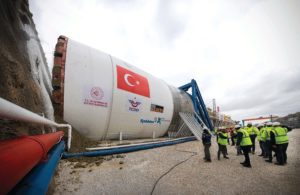
The large diameter Robbins Crossover TBM has bored nearly 500 m (1,600 ft) in gneiss and mudstone as of May 2021.
To convert to hard rock mode, the mixing bars and initial portion of the screw conveyor can be optionally retracted. EPB knife bits are then replaced with disc cutters on the cutterhead, and the EPB scrapers on the cutterhead are replaced with bucket lips. Muck paddles are installed in the cutterhead to allow the muck to fall into the muck chute. A hydraulic muck ring allows a chute attached to the bulkhead to move forward and down at a diagonal angle, allowing rock chips to be deposited in the chute and through the screw conveyor onto the TBM belt conveyor. To keep up production rates in both modes, the Robbins Torque-Shift System is used: a two-speed gearbox that enables efficient tunneling in hard, mixed, or soft ground.
The Eşme-Salihli Railway Tunnel is part of the Ankara-İzmir High Speed Railway Project for the Turkish State Railways (TCDD). The 508 km (316 mi) line will eventually connect Polatlı in Ankara Province to Izmir, the third most populous city in Turkey, surpassing the Istanbul-Ankara High-Speed Railway as the longest rail line in the country once complete. The double-track railway system will convey passengers at top speeds of 250 km/h (160 mph), completing the journey between the two cities in 3.5 hours—a journey that would normally take 6.5 hours by car.
China’s Largest Robbins Crossover TBM launches on Intercity Railway
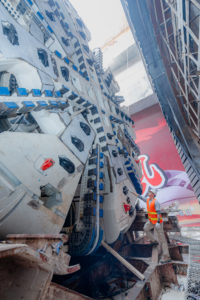
A crew member inspects the cutterhead of the Robbins Crossover XRE TBM during assembly in Guangzhou.
The largest ever Crossover (XRE) TBM in China launched in late March 2021 in Guangzhou for contractors Sichuan Jinshi Heavy Equipment Leasing Co., Ltd and CREC Bureau 2. Onsite First Time Assembly (OFTA) was utilized to build the 9.16 m (30 ft) diameter Robbins TBM, taking just five months from the start of assembly to machine launch. The hybrid machine is boring the 2.5 km (1.6 mi) long Pazhou Line Lot PZH-1 of the Pearl River Delta Intercity Railway Project, which will offer better commutes for Guangzhou residents traveling to and from University City.
The machine will encounter various ground types during its bore, from moderately to strongly weathered argillaceous shales and sandstone to mixed face conditions. Much of the rock is fractured, while the quartz content is as high as 50 percent. “Not only are there poor ground conditions such as soft to hard uneven, fractured zones and full-face hard rock, but these sections appear to alternate frequently, which is the biggest challenge of the project. It will be a test of performance and tunneling efficiency for the machine,” said Yongsheng Qi, Project Manager for Robbins China. The tunnel is also expected to cross under rivers and other bodies of water with a cover of 20 to 31 m (65 to 100 ft). The ground strata connects to the river and is highly permeable, resulting in expected water pressures above 7 bar. The project’s success lies in stabilizing the water pressure at the face while ensuring acceptable advance rates and construction safety.
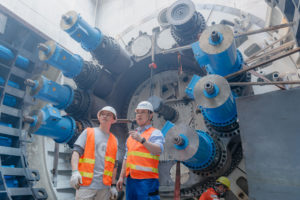
Onsite First Time Assembly (OFTA) of the Crossover XRE took just five months from start of assembly to launch.
The Crossover TBM features both hard rock and EPB modes and is optimized for the rapidly changing ground found on the project. An adaptable cutterhead design and two-speed gear reducers known as the Robbins Torque-Shift system enable efficient tunneling in hard, mixed, and soft ground. An adaptable screw conveyor can be mounted in the center or bottom of the mixing chamber depending on the mode. To combat high water pressures the machine is fitted with high pressure seals and can statically hold up to 30 bar. The XRE TBM began its excavation in EPB mode and will shift to hard rock mode to continue excavation after 1.5 km (0.9 mi) has been bored.
The unique project is one of several mixed ground operations using Robbins Crossover TBMs in China. Two 6.91 m (22.6 ft) diameter XRE machines are currently boring sections of the Chongqing Metro Phase 2 in ground conditions ranging from weathered mixed granite to weathered pegmatite and adamellite. The project is under the same contractors as the Pearl River Delta bore. “At the Chongqing Metro project, we won the trust of the contractor with the performance of the Crossover machines; to date the highest monthly advance rate in Chongqing is 365 m (1,197 ft). This is one of the main reasons the contractor again selected a Robbins Crossover TBM for the Pearl River Delta project,” observed Qi.
With rates at Chongqing Metro as a precedent, the Pearl River Delta tunnel is scheduled to be completed by the end of 2021 and put into operation in 2023.
Robbins enters a New Chapter
Global TBM Company, newly established by industry veteran Lok Home, is proud to announce the recent purchase of substantially all the assets of The Robbins Company. The company will operate as Robbins and with Mr. Home as the President and CEO. The acquisition will result in a seamless transition for a number of ongoing projects throughout the world, as Robbins renews its commitment to service, quality underground equipment, and top-notch support that its customers have come to expect. For a brief message from Lok Home, view the video here.
Home said the company has a bright future as a result of the transaction. We are starting off the new year with a respectable backlog of orders,” he noted. “In 2021 and beyond, our clients can depend on Robbins to deliver high quality machines, and technically superior machines for very difficult projects,” said Home. “That’s where Robbins really stands out.”
Home went on to say that Robbins is starting 2021 with no significant bank or institutional debt. “We have many projects to look forward to,” he continued. “Robbins is currently delivering Crossover machines and TBMs equipped for challenging geological conditions in many countries including the U.S., Norway, India, China and Canada.” The company’s conveyor and small boring machine divisions will also continue to deliver equipment worldwide.
Home emphasized that Robbins has always been focused on building the best and strongest machines. He pledged that they will continue to do that. “We still have our strong engineering team and we plan to continue our many industry involvements including the International Tunneling Association (ITA) and its associate member organizations. We’re glad to be a part of this community and this industry,” Home added.
The company expects to continue with exciting new developments as well, including a soon-to-be-unveiled non-circular rock boring machine. Robbins remains focused on creativity and innovation to solve the industry’s greatest challenges.
About Robbins
Robbins is one of the world’s foremost developers and manufacturers of advanced, underground construction machinery. Headquartered in Solon, Ohio, USA, Robbins is a total supply firm offering customized Tunnel Boring Machines, conveyors, cutters, and more, as well as knowledgeable field service personnel and technical support. The company has been an active industry participant and innovator for nearly 70 years.
From the first modern Tunnel Boring Machine built in 1952 to recent innovations such as the Crossover TBM for varied ground conditions, Robbins engineering and innovations have made a success of the world’s most difficult tunneling projects.
Robbins Main Beam carves out a win in Louisville
A 6.5 km (4 mi) long tunnel for wastewater storage below Louisville, Kentucky, USA has more to it than meets the eye. “At first glance, this seems like a straightforward project, but it turned out to be much more challenging,” said Shemek Oginski, Project Manager for the contractor, a joint venture of Shea/Traylor. The 6.7 m (22 ft) diameter Robbins Main Beam TBM and conveyor system had to cope with overstress in the crown that resulted in significant rock fallout in seven different areas, as well as methane gas in the tunnel. By the machine’s breakthrough on September 22, 2020, the crew had much to celebrate.
The machine was refurbished and consisted of older components as well as a brand new cutterhead supplied by Robbins and completely rebuilt electrical and hydraulic systems. “This was definitely an older machine—I actually operated it on the DART [Dallas Area Rapid Transit] tunnels in Dallas, Texas in the 1990s, but with many of the components being new we were confident in it,” said Oginski.
The original tunnel was expected to be 4 km (2.5 mi) long, but a change order added to the length by 2.1 km (1.3 mi). The extension was ordered by the owner, Louisville Metropolitan Sewer District (MSD), and its Engineer-of-Record Black & Veatch in order to eliminate four surface CSO storage basins. That included one basin originally located at the site of the TBM breakthrough, explains Oginski: “The original CSO site was located in close proximity to Beargrass Creek and had flooded multiple times. It was decided to extend the tunnel to that site in order to use the tunnel as storage instead, and connect it to the sewer system.” MSD installed a sheeting wall to protect the site from floodwaters while Shea-Traylor installed liner plate in the retrieval shaft, resulting in a site that is in much better shape.
It was in the 2.1 km (1.3 mi) extension, essentially a bifurcation of the main tunnel, where the crew encountered much of the crown overstress. “The longest section of overstress was 700 m (2,300 ft) and took two and a half months to get through,” said Oginski. The crew switched up the prescribed rock bolt pattern of four to six bolts at 1.5 m (5.0 ft) centers, and instead installed six bolts at 1 m (3 ft) centers. “It worked out to two rows per push. When that wasn’t enough, we installed wire mesh in the crown, mine straps, and channels. It definitely took extra time to install steel support, remove loose rock, and deal with the rock coming down so we could install rock support safely.” Overbreak varied from a few inches above the machine to 30 cm (1 ft) or more.
“We also had encountered natural methane gas in the tunnel just shortly before holing through,” said Oginski. The methane was discovered while the crew were probing out 150 ft ahead of the machine—something that the crew did continuously throughout the bore, using one, two or four probe holes depending on the geology. “We were down for about two weeks and were able to contain the methane within the cutterhead, where concentration spiked at 100% LEL. We were able to resume work after systematically ventilating, probing and grouting multiple times.”
Despite the challenges, the TBM was able to achieve up to 658 m (2,159 ft) in one month and 192 m (630 ft) in one week. The Robbins conveyor, including a 68.6 m (225 ft) long vertical belt, made this progress achievable, said Oginski: “The conveyor is definitely the way to go, especially for longer drives. There was quite a difference in performance between the extension tunnel, which we mined with lift-boxes, and mining with the conveyor. Our best month in the extension tunnel with the boxes was 221 m (725 ft), so that is a big difference.”
With tunneling now complete, Oginski is “definitely proud that we got to the end, as this is a challenging project.” The contractor is removing the components of the TBM to be stored in their yard in Mt. Pleasant, PA, and sees future applications for the equipment. “If the right project comes up then yes, it’s likely we would use this machine again.”
Robbins Single Shield breaks through Turkey’s Hardest Rock
On July 24, 2020, a jubilant ceremony marked a milestone for southern Turkey’s arduous Bahçe-Nurdaği High-Speed Railway Tunnel. The first TBM-driven portion of tunneling using an 8.0 m (26.2 ft) diameter Robbins Single Shield machine is now complete. The 8.9 km (5.5 mi) long TBM tunnel was no easy bore, as it was excavated through some of the hardest and most abrasive rock ever encountered in the country.
“We are proud of the TBM crew who acted rapidly and were well organized to overcome the challenging ground conditions with a unique Single Shield TBM for the completion of the first tube of the Bahçe-Nurdağı Railway Project,” said Deniz Sahin, TBM Chief for contractor Intekar Yapi A.Ş.
Ground conditions during tunneling ranged from abrasive, interbedded sandstone and mudstone with quartzite veins to highly weathered shale and dolomitic limestone. The TBM encountered rock measuring between 136 and 327 MPa (19,700 to 47,400 psi) UCS. Water ingress with fines was expected in fault lines and shear zones affected by the East Anatolian Fault. “The TBM became stuck in three different fault zones, which we got through by building bypass tunnels. In smaller fault zones, we encountered excessive material flow and the TBM had to be stopped, while ground had to be stabilized with chemical injections while we cleaned the cutterhead,” said Sahin. Water inflows of 10 liters per second on average were removed using a dewatering system.
The majority of tunneling, said Sahin, was in metasandstone with quartz, with an average of 220 MPa (31,900 psi) UCS and a Cerchar abrasion value of 3.87. In such regions, the TBM’s 19-inch back-loading disc cutters had to be changed frequently and there was high vibration. Despite the challenges, Sahin was impressed by the machine’s overall capacity: “The Robbins Single Shield TBM’s motor power, hydraulic power and cutterhead torque were quite strong. The secondary ventilation and air suction systems inside the TBM were powerful. The connections between the gantries, scaffolding systems, walkways and working areas were good.”
The TBM ultimately achieved up to 456 m (1,500 ft) per month, a result achieved with the help of a Robbins continuous conveyor system for muck removal. “The electric motor and gearbox capacity of the conveyor system was quite enough for a 10 km (6.2 mi) tunnel and we had no failure on them. The conveyor performed well even under excess material and the whole system was quite robust,” said Sahin.
The owner, Turkish State Railways Directorate (TCDD), is aiming to overhaul the railway connection in southeastern Turkey by providing a shorter, faster route in one of the country’s busiest railway corridors. The new rail line between the towns of Bahçe and Nurdağı includes two parallel 9.8 km (6.1 mi) tunnels being excavated by both NATM (850 m / 0.5 mi) and TBM (8.9 km / 5.5 mi).
Tough TBM breaks through after navigating Faults, Karst, and More
In January 2020, a Robbins 5.97 m (19.6 ft) diameter Main Beam TBM cleared its final hurdle when it broke through in Guangxi Province, China. The TBM excavated its first of two tunnels, an 11.9 km (7.4 mi) long conduit for Lot 1 of the North Line Water Irrigation Project, Letan Water Reservoir, Drought-Relief. The tunnel was marked by a gauntlet of challenges, from karst cavities to fault zones and water inflows. The workers on the jobsite, contractor Guangdong No. 2 Hydropower Bureau Co., Ltd., and the owner, Construction Management Bureau for the Letan Water Reservoir, had much to celebrate after completion of what is widely regarded as the most complex and longest tunnel on the North Line project.
Boring with the Robbins Main Beam TBM and continuous conveyor system began in summer 2015. “There was no precedent in this province for using a Main Beam TBM to excavate a tunnel longer than 10 km. We didn’t have relevant local experience to use for reference,” explained Yongjiu Jin, Deputy Manager of the Project for contractor Guangdong No. 2 Hydropower Bureau Co., Ltd. The machine did encounter a number of difficult geological obstacles as it bored through limestone rock, but was still able to achieve advance rates up to 40 m (130 ft) per day in good ground.
Much of the geology consisted of lightly weathered limestone in rock class II to III, with some sections in class IV to V rock that required the heaviest amount of ground support, ranging from rock bolts to ring beams and mesh. “Our team encountered a coal seam, gasses in the tunnel, two large water inrushes, three fault zones up to 103 m long, 11 karst cavities, and more. In order to solve the ground problems, there were more than 160 special technical research meetings held,” said Yongjiu.
Throughout tunneling, the contractor expressed thanks for Robbins Field Service staff. “Robbins personnel provided good technical support from equipment installation and commissioning through to tunnel completion. After the equipment was handed over to our company, they still helped us with equipment usage on our project, which makes us very satisfied with the Robbins after-sales service. Robbins really delivered: the after-sales phase was not the end of service, but the beginning of site service,” said Yongjiu.
While the completion of the first tunnel—the longest single-heading construction on record for water tunnels in Guangxi—is a milestone, there is more to do. The Robbins machine will be inspected and relaunched to bore a second tunnel 4.2 km (2.6 mi) in length. The ground conditions are predicted to be equally challenging, but the tunneling operation has some help from ground prediction methodology. Tunnel Reflection Tomography (TRT)—consisting of ground prediction using seismic waves—is being used to detect changing conditions ahead of the TBM. The method can predict the distribution and scale of joints and fissures, allowing the crew to plan ahead.
Located near Laibin City, the North Line project provides much needed drought relief using a network of tunnels totaling 29.4 km (18.3 mi). “This tunnel will realize the dream of drought control that people in Central Guangxi have had for many years. The breakthrough is the most important milestone event in this first phase of the North Line project,” said Yongjiu.

 Close
Close  Menu
Menu 